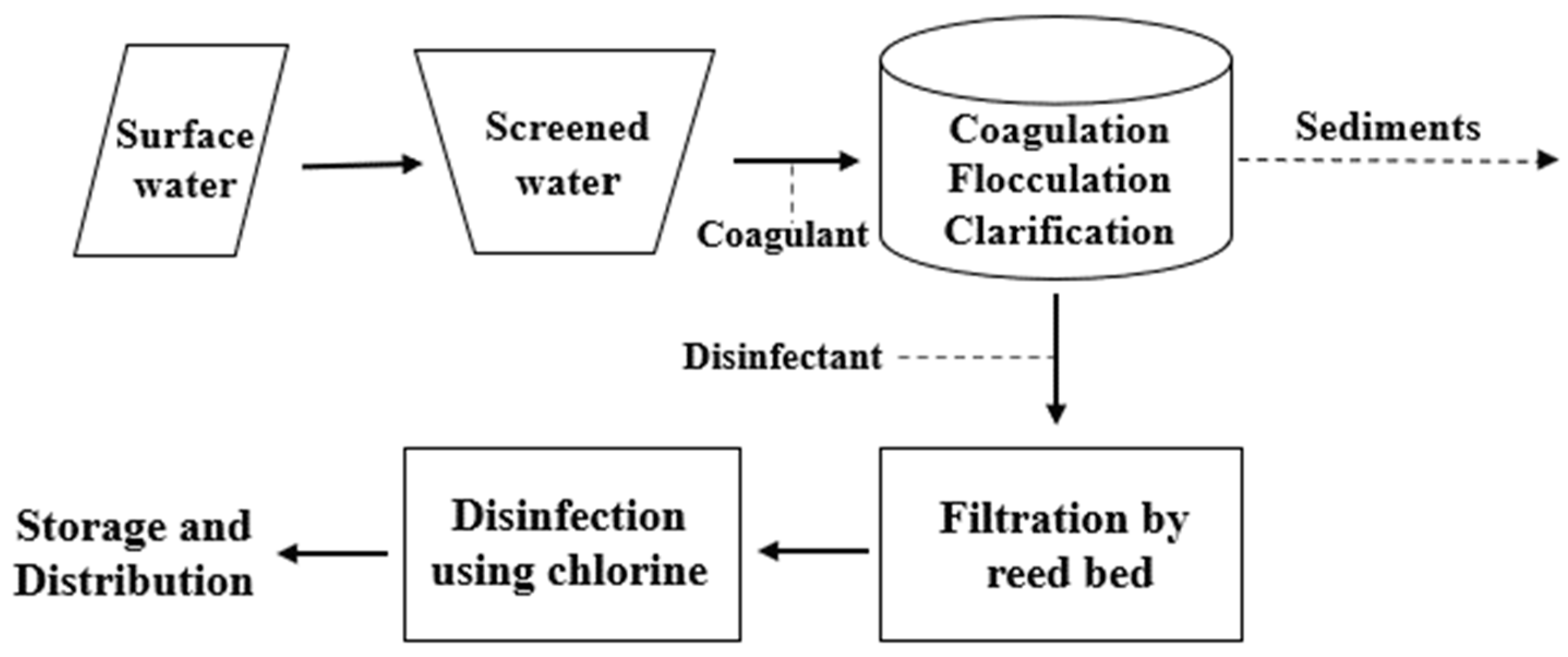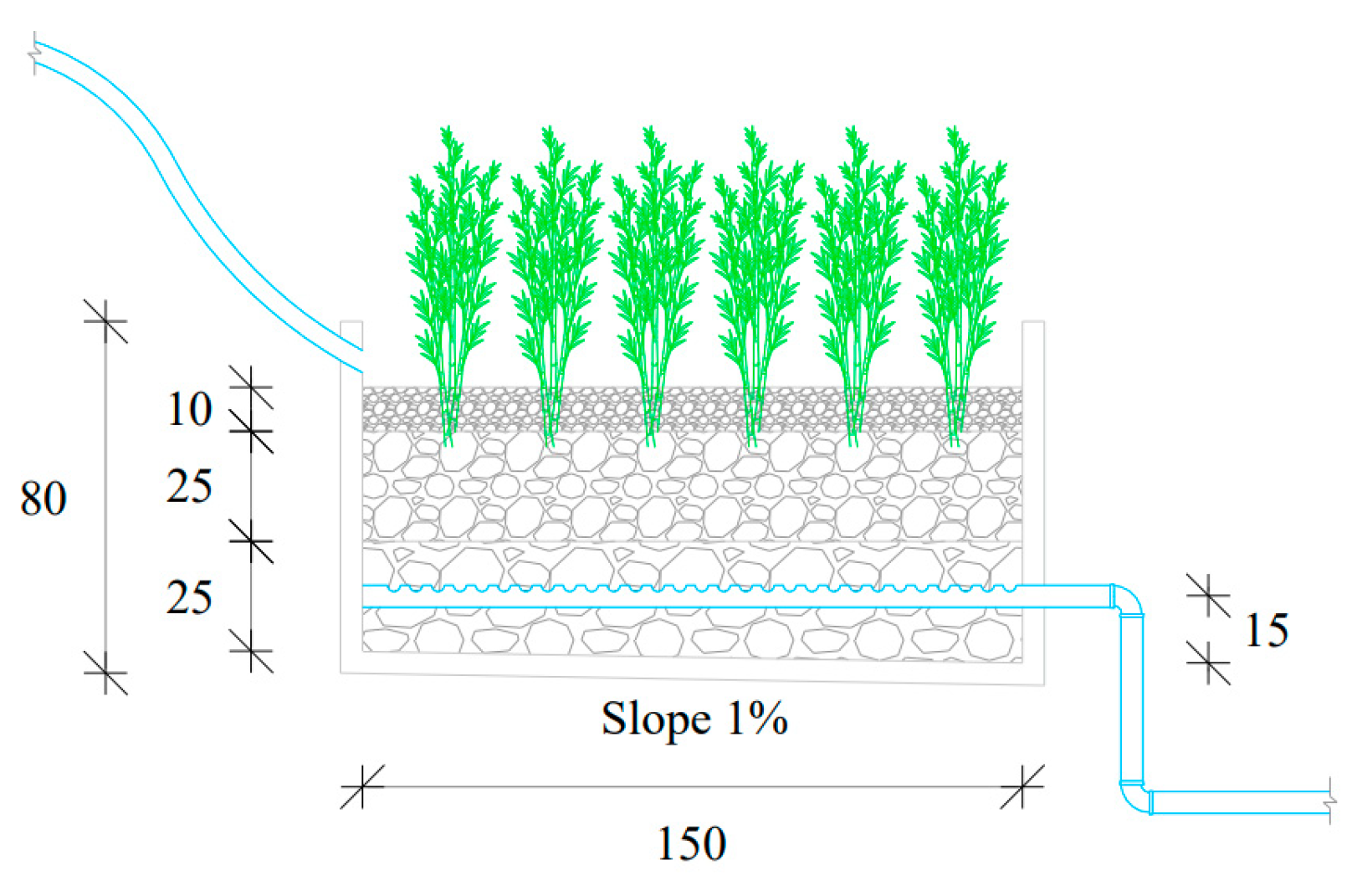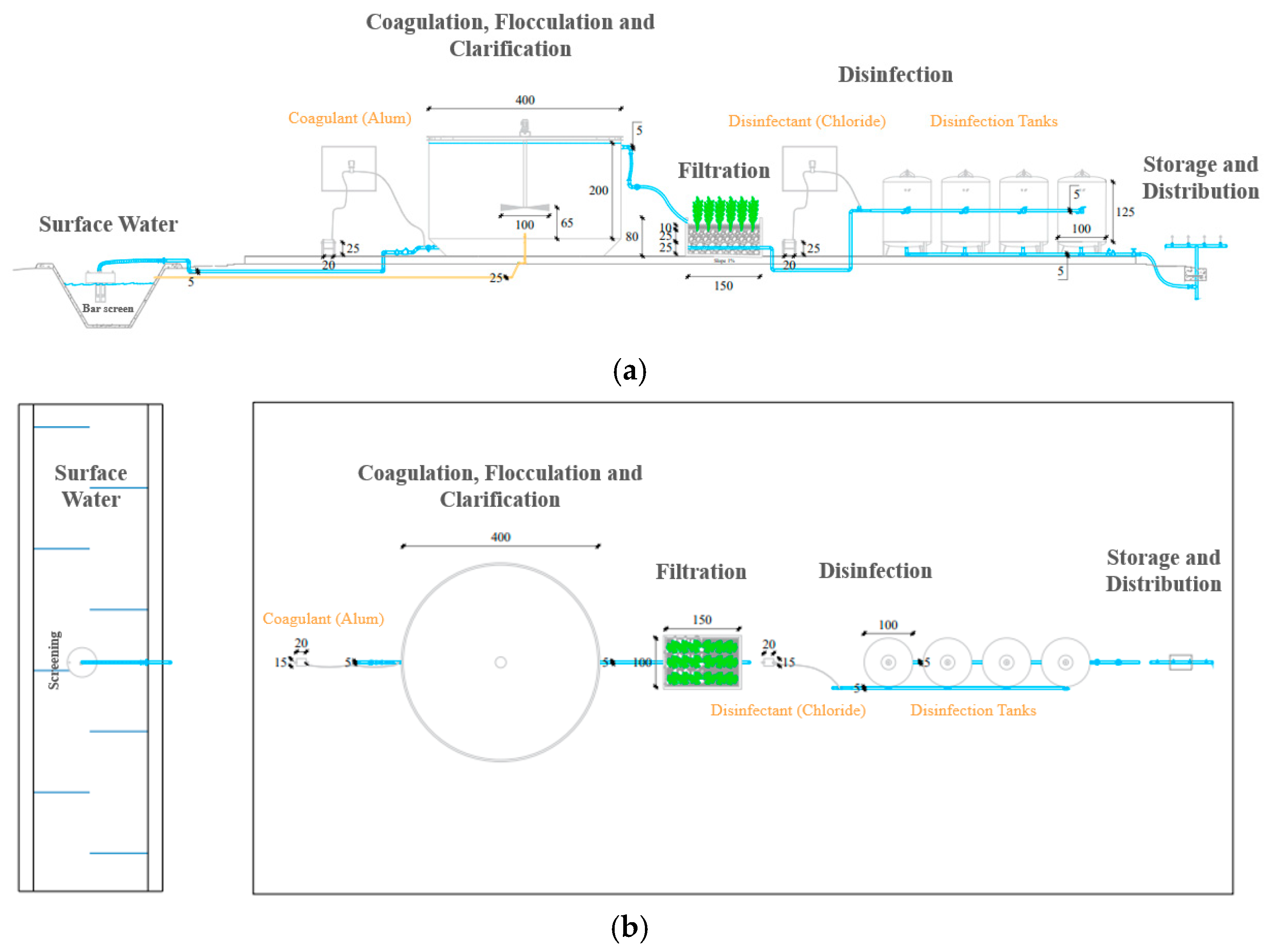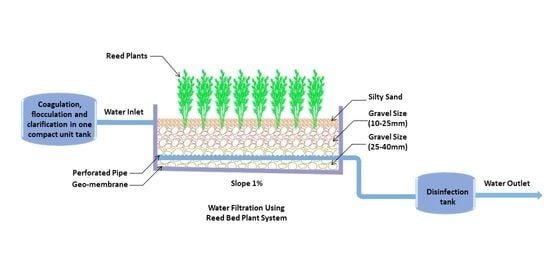Conceptual Design of a Compact Water Purification Unit Using Reed Bed Filtration
Abstract
1. Introduction
2. Compact Water Purification Treatment Unit
2.1. Process Flow Diagram
2.2. Conceptual Design
2.2.1. Inlet Pipe Design
2.2.2. Coagulant Tank Design
2.2.3. Circular Tank Design
- For rapid mixing during coagulation, the detention time should be 10 < DT < 60 s [18]. Taking DT = 20 s, the required volume will be 0.04 m3 based on Equation (4).where V is the circular tank volume (m3), Qavg is the average flowrate (m3/s), and DT is the detention time (s).
- For the clariflocculation, the detention time should be between 2 and 4 h. Assuming that the time it takes to complete the flocculation and clarification respectively, is 30 and 150 min [18], therefore the total detention time in this phase is 180 min. Using Equation (4), the required volume will be 21.6 m3.
2.2.4. Propeller Design
- For rapid mixing operating for 20 s, the rate of change of velocity should be 600 m/s/m < G < 1000 m/s/m, taking G equal to 1000 m/s/m the corresponding power of the mixer during this phase will be 25,349 W.
- For flocculation operation for 30 min, the velocity gradient will be taken 50 m/s/m then the propeller power will be 64 W.
2.2.5. Sludge Removal Pipe Design
2.2.6. Filtration
- Bottom layer: made of gravel of size 25 to 40 mm with a 25 cm thickness.
- Middle layer: made of gravel of size 10 to 25 mm with a 25 cm thickness.
- Top layer: made of silty sand with a 10 cm thickness.
2.2.7. Disinfection
3. Impact
- SDG number 3: “Good health and well-being”, by eliminating water borne diseases that cause serious health issues.
- SDG number 6: “Clean water and sanitation”, achieved by providing water that is palatable, odorless, and visually appealing
- SDG number 13: “Climate action”, achieved by ensuring the safe and easy disposal of used materials.
4. Conclusions
Author Contributions
Funding
Data Availability Statement
Conflicts of Interest
References
- Ali, I. Water treatment by adsorption columns: Evaluation at ground level. Sep. Purif. Rev. 2014, 43, 175–205. [Google Scholar] [CrossRef]
- Shannon, M.A.; Bohn, P.W.; Elimelech, M.; Georgiadis, J.G.; Marinas, B.J.; Mayes, A.M. Science and technology for water purification in the coming decades. Nature 2008, 452, 301–310. [Google Scholar] [CrossRef] [PubMed]
- World Health Organization. Guidelines for Drinking-Water Quality; World Health Organization: Geneva, Switzerland, 2004; Volume 1.
- Jain, S.K.; Agarwal, P.K.; Singh, V.P.; Jain, S.K.; Agarwal, P.K.; Singh, V.P. Water quality and related aspects. Hydrol. Water Resour. India 2007, 57, 997–1033. [Google Scholar]
- Tong, Y.; McNamara, P.J.; Mayer, B.K. Adsorption of organic micropollutants onto biochar: A review of relevant kinetics, mechanisms and equilibrium. Environ. Sci. Water Res. Technol. 2019, 5, 821–838. [Google Scholar] [CrossRef]
- Noubactep, C.; Caré, S.; Crane, R. Nanoscale metallic iron for environmental remediation: Prospects and limitations. Water Air Soil Pollut. 2012, 223, 1363–1382. [Google Scholar] [CrossRef] [PubMed]
- Gonzalez-Perez, A.; Persson, K.M.; Lipnizki, F. Functional channel membranes for drinking water production. Water 2018, 10, 859. [Google Scholar] [CrossRef]
- Ali, I. New generation adsorbents for water treatment. Chem. Rev. 2012, 112, 5073–5091. [Google Scholar] [CrossRef] [PubMed]
- Chen, W.; Mo, J.; Du, X.; Zhang, Z.; Zhang, W. Biomimetic dynamic membrane for aquatic dye removal. Water Res. 2019, 151, 243–251. [Google Scholar] [CrossRef] [PubMed]
- Patel, A.; Shah, A. Sustainable solution for lake water purification in rural and urban areas. Mater. Today Proc. 2020, 32, 740–745. [Google Scholar] [CrossRef]
- Shabiimam, M.; Kazi, T.; Anas, P.; Shifa, S. Treatment of water using various filtration techniques: A review study. In Proceedings of the 3rd International Conference on Construction, Real Estate, Infrastructure and Project (CRIP) Management, Pune, India, 23–25 November 2018; pp. 229–235. [Google Scholar]
- Yang, H.; Hu, R.; Ndé-Tchoupé, A.I.; Gwenzi, W.; Ruppert, H.; Noubactep, C. Designing the next generation of Fe0-based filters for decentralized safe drinking water treatment: A conceptual framework. Processes 2020, 8, 745. [Google Scholar] [CrossRef]
- Goldstein, R.; Smith, W. Water & Sustainability (Volume 4): US Electricity Consumption for Water Supply & Treatment—The Next Half Century; Electric Power Research Institute: Washington, DC, USA, 2002. [Google Scholar]
- Bukhary, S.; Batista, J.; Ahmad, S. Design aspects, energy consumption evaluation, and offset for drinking water treatment operation. Water 2020, 12, 1772. [Google Scholar] [CrossRef]
- Bukhary, S.; Weidhaas, J.; Ansari, K.; Mahar, R.B.; Pomeroy, C.; VanDerslice, J.A.; Burian, S.; Ahmad, S. Using Distributed Solar for Treatment of Drinking Water in Developing Countries. In Proceedings of the World Environmental and Water Resources Congress 2017, Sacramento, CA, USA, 21–25 May 2017; pp. 264–276. [Google Scholar]
- Plappally, A.K.; Lienhard, J.H. Costs for water supply, treatment, end-use and reclamation. Desalination Water Treat. 2013, 51, 200–232. [Google Scholar] [CrossRef]
- Price, J.I.; Heberling, M.T.; Nietch, C.T. Economic support for decisions on source water protection. J. -Am. Water Work. Assoc. 2018, 110, 56. [Google Scholar] [CrossRef] [PubMed]
- Jagadeesh, A. Safe drinking water for all through solar disinfection. J. Rural Dev. 2010, 58, 11–13. [Google Scholar]
- American Water Works Association. Water Treatment Plant Design; McGraw-Hill Education: New York, NY, USA, 2012. [Google Scholar]
- Davis, M.L. Water and Wastewater Engineering: Design Principles and Practice; McGraw-Hill Education: New York, NY, USA, 2010. [Google Scholar]
- Hendricks, D.W. Water Treatment Unit Processes: Physical and Chemical; CRC Press: Boca Raton, FL, USA, 2018. [Google Scholar]
- Prasad, R.K.; Chatterjee, S.; Sn, D.; Sharma, S.; Vairale, M.; Veer, V. Reed Bed Plants & Their Role in Waste Water Treatment & Reclamation. In Proceedings of the National Conference on Recent Advances in Biodegradation of Human Wastes, Tezpur, India, 16–17 December 2014. [Google Scholar]
- Lee, C.; Lin, S.D. Handbook of Environmental Engineering Calculations; McGraw-Hill Education: New York, NY, USA, 2007. [Google Scholar]
- Hering, J.G.; Maag, S.; Schnoor, J.L. A call for synthesis of water research to achieve the sustainable development goals by 2030. Environ. Sci. Technol. 2016, 50, 6122–6123. [Google Scholar] [CrossRef] [PubMed]



| Number of Conduits | One Minimum, Two or More Preferred |
|---|---|
| Velocity | 1.2–2.0 ft/s (46–61 cm/s) at design flow; 3–4 ft/s (90–120 cm/s) maximum |
| Type of construction | Tunnel or pipeline |
| Slope or grade | Continuous to drain or to an air release valve |
| Geometric Ratio | Range |
|---|---|
| D/T (radial) | 0.14–0.5 |
| D/T (radial) | 0.17–0.4 |
| H/D (either) | 2.0–4.0 |
| H/T (axial) | 0.34–1.6 |
| H/T (radial) | 0.28–2.0 |
| B/D (either) | 0.7–1.6 |
Disclaimer/Publisher’s Note: The statements, opinions and data contained in all publications are solely those of the individual author(s) and contributor(s) and not of MDPI and/or the editor(s). MDPI and/or the editor(s) disclaim responsibility for any injury to people or property resulting from any ideas, methods, instructions or products referred to in the content. |
© 2023 by the authors. Licensee MDPI, Basel, Switzerland. This article is an open access article distributed under the terms and conditions of the Creative Commons Attribution (CC BY) license (https://creativecommons.org/licenses/by/4.0/).
Share and Cite
Farah, E.; Khalil, M.; Richa, M.; Abou Harb, C. Conceptual Design of a Compact Water Purification Unit Using Reed Bed Filtration. Separations 2023, 10, 194. https://doi.org/10.3390/separations10030194
Farah E, Khalil M, Richa M, Abou Harb C. Conceptual Design of a Compact Water Purification Unit Using Reed Bed Filtration. Separations. 2023; 10(3):194. https://doi.org/10.3390/separations10030194
Chicago/Turabian StyleFarah, Elias, Maria Khalil, Manuella Richa, and Chantal Abou Harb. 2023. "Conceptual Design of a Compact Water Purification Unit Using Reed Bed Filtration" Separations 10, no. 3: 194. https://doi.org/10.3390/separations10030194
APA StyleFarah, E., Khalil, M., Richa, M., & Abou Harb, C. (2023). Conceptual Design of a Compact Water Purification Unit Using Reed Bed Filtration. Separations, 10(3), 194. https://doi.org/10.3390/separations10030194










